Genus Onychogalea | Phylum Chordata Scientific name Onychogalea fraenata Rank Species | |
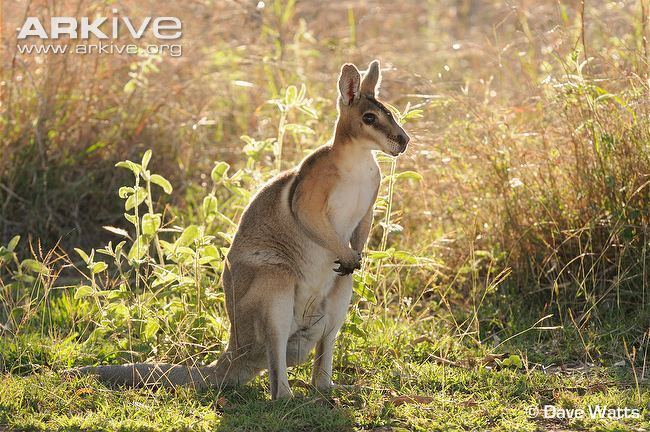 | ||
Similar Nail‑tail wallaby, Mammal, Whiptail wallaby, Banded hare‑wallaby, Lagorchestes | ||
The bridled nail-tail wallaby (Onychogalea fraenata), also known as the bridled nail-tailed wallaby, bridled nailtail wallaby, bridled wallaby, merrin, and flashjack, is a vulnerable species of macropod. It is a small wallaby found in three isolated areas in Queensland, Australia, and whose population is declining. The total population of the species is currently estimated to be less than 1,100 mature individuals in the wild.
Contents
- Bridled nail tail wallaby alma street veterinary hospital
- Description
- Distribution and habitat
- Ecology and behaviour
- Recovery efforts
- Scientific significance
- References
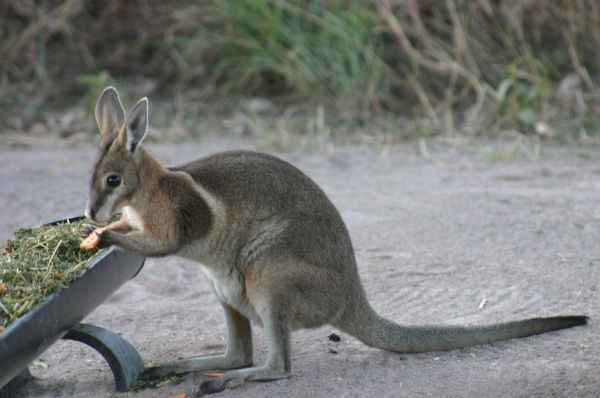
Bridled nail tail wallaby alma street veterinary hospital
Description

This small wallaby is named for two distinguishing characteristics: a white "bridle" line that runs down from the back of the neck around the shoulders, and the horny spur on the end of its tail. Other key physical features include a black stripe running down the dorsum of the neck between the scapulae, large eyes, and white stripes on the cheeks, which are often seen in other species of wallabies as well.

The bridled nail-tail wallaby can grow to one metre in length, half of which is tail, and weighs 4–8 kg. Females are somewhat smaller than the males. The tail spur can be 3–6 mm long and partly covered in hair. Its purpose is unclear.
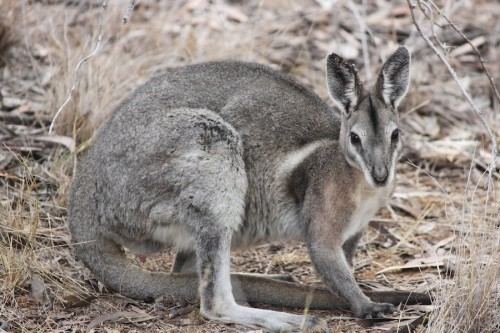
The "nail-tail" is a feature common to two other species of wallabies: the northern nail-tail wallaby and the crescent nail-tail wallaby (which was declared to be extinct in 1956).
Distribution and habitat

At the time of European settlement of Australia, bridled nail-tail wallabies were common all along the East Australian coastline region to the west of the Great Dividing Range. Naturalists in the 19th century reported that the species ranged from the Murray River region of Victoria through central New South Wales to Charters Towers in Queensland.
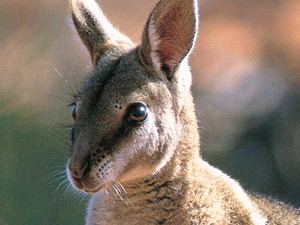
The species declined in the late 19th and early 20th centuries with no confirmed sightings between 1937 and 1973, by which time it was believed to be extinct. After reading an article in a magazine about Australia's extinct species, a fencing contractor reported that there was an extant population on a property near Dingo, Queensland. This sighting was subsequently confirmed by researchers from the Queensland Parks and Wildlife Service, and the property eventually became Taunton National Park, a scientific nature reserve for the purpose of ensuring the ongoing survival and protection of this endangered species. The current range of this wallaby is less than 5% of its original range.
Ecology and behaviour
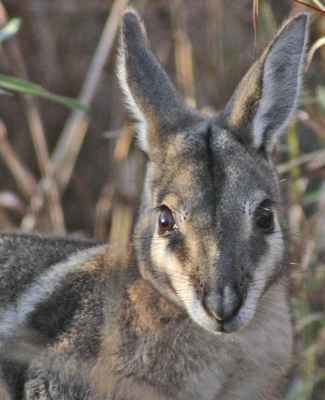
The wallabies are most active during the night-time and dusk periods. Day is usually spent sleeping in hollows near bushes or trees. In modern habitats, nail-tails keep close to the edges of pasture grasses. These wallabies have a reputation as shy and solitary animals. They may occasionally form small groups of up to four to feed together when grazing is in short supply. The bridled nail-tail wallaby likes to avoid confrontation and has two main ways of avoiding threats – hiding in hollow logs and crawling under low shrubs. If caught in the open, it may try to lie completely still hoping not to be observed. After a gestation period of about 23 days, the single joey undergoes further development in the mother's pouch for around four more months.
Recovery efforts
Since its rediscovery, the bridled nail-tail wallaby has been the target of private conservation efforts to re-establish viable populations. Captive breeding programs have allowed the establishment of three populations; two in State reserves located at Idalia and Taunton National Parks, and another on a private reserve, Project Kial, located near Marlborough in Central Queensland. The extant population is currently estimated to be less than 1,100 mature individuals in the wild.
In the early 1900s this species suffered dramatically from shooting, for its fur and because it was considered a pest. Current threats to the species include predation by introduced species such as feral cats, red foxes, and dingoes. Other threats include wildfires, prolonged drought, habitat destruction by the pastoral industry and competition for food from grazers, such as rabbits and domestic sheep.
Scientific significance
The bridled nail-tail wallaby is of interest to marsupial researchers because it appears to have a more vigorous immune system than other species of macropods. In the words of Central Queensland University based marsupial immunologist Lauren Young, "These wallabies appear to be able to survive parasite infections, viruses and various diseases more readily than other marsupials".
